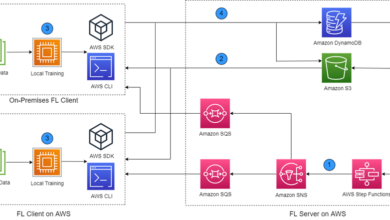Definition, Key Features and Benefits

A hybrid cloud is a computing framework where private cloud, on-premises infrastructure and public cloud blend to serve as a single computing ecosystem. It’s a cloud architecture that integrates some level of workload portability, storage, network orchestration and management across two or more cloud computing environments.
Given the rise in computing needs and the benefits a hybrid cloud strategy offers businesses, the hybrid cloud market has been on a boom and is projected to reach $262 billion by 2027. Let’s look at what some of these benefits are and the key features of a hybrid cloud environment.
Jump to:
How does hybrid cloud work?
Depending on the organization and how they choose to deploy, a hybrid cloud could work as a combination of on-premises infrastructure with a public cloud or as a blend of private cloud and public cloud. Whichever way it’s set up, a hybrid cloud creates a unified and flexible computing environment.
SEE: Explore this hybrid cloud cheat sheet.
For example, with a public and private cloud setup, organizations can run applications and store data in the public cloud to benefit from its scalability and cost-effectiveness while keeping sensitive or critical data and applications in their private cloud for enhanced security and compliance.
To facilitate data integration and portability between the two environments, organizations could use cloud management platforms. This integration allows organizations to monitor what happens in their hybrid environment, optimize resource utilization, easily scale during peak demand, and ensure data redundancy and disaster recovery for business continuity.
Hybrid cloud examples
A hybrid cloud strategy is used across many enterprises today, especially in highly regulated industries where there are strict data privacy laws that define how data is stored and processed.
A typical example is the financial services sector, which has strict regulatory requirements due to the high rate of potential risks. Many organizations in this sector can deploy a private cloud to manage sensitive financial transactions and client data, while utilizing the public cloud for less sensitive tasks like marketing campaigns or web hosting.
The same strategy is possible in the healthcare industry. In this case, patient records and confidential information are stored in a private cloud, while nonsensitive applications such as appointment scheduling or patient education materials can be hosted in a public cloud for easy accessibility and cost efficiency.
Key features of hybrid cloud
Below are some of the features of a hybrid cloud environment:
- Dynamic workloads: With a hybrid cloud, businesses can easily utilize both the public cloud for dynamic workloads and the private cloud for more sensitive or volatile workloads.
- Big data processing: A hybrid cloud is configured to handle fluctuating volumes of big data analytics on the public cloud while ensuring the protection of sensitive data through the use of the private cloud.
- Make change at your own pace: Hybrid cloud architecture makes it easy to test where specific workloads work best, allowing you to see what works for your enterprise.
- Backups and disaster recovery flexibility: A hybrid cloud offers flexible backup and disaster recovery options for data based on volume and sensitivity, making it easier for organizations to choose between public, private or on-premises solutions.
Benefits of hybrid cloud
Scalability
Under private cloud infrastructure, businesses face many obstacles when trying to scale their workloads. For instance, if a need for expansion arises, enterprises will need to commit a lot of finance to make that work; they may need to purchase more physical machines, which must be installed and maintained at extra cost.
SEE: What’s the difference between multicloud and hybrid cloud?
However, this bottleneck is removed with a hybrid cloud, as businesses can easily rely on the public cloud to add more computational power to their IT system. In other words, a hybrid cloud removes the need to purchase extra servers for on-premises infrastructure, as businesses can easily utilize the resources provided by a public cloud service.
Control
Every business owner wishes to be in total control of their entire business infrastructure, and the hybrid cloud offers a great deal of that. Through a hybrid cloud environment, businesses can avoid leaving all of their IT infrastructure in the hands of a third-party cloud provider. In addition, a hybrid cloud will make it possible for businesses to determine how to customize the private side of their cloud infrastructure when adjustments need to be made.
Speed
With hybrid cloud, latency can easily be reduced by optimizing infrastructure with edge computing. Since businesses have the advantage of controlling their own network infrastructure, they can easily simplify how data is transferred and processed within the computing ecosystem.
This isn’t to say that the hybrid cloud is faster than a public cloud environment. However, the point is that a hybrid cloud offers the flexibility that makes it possible to customize operations in the most efficient way possible.
Security
Through the hybrid cloud, businesses can better control the security measures they can apply to their IT system while benefiting from the bigger computing power a public cloud offers. In addition, with the public cloud being a major target for hackers, organizations can save their enterprise by adapting quality security practices they deem necessary to their private cloud without losing the gains of the public cloud.
SEE: Here are 10 ways to protect your business data.
One way this can be achieved is through encryption. Since data still gets moved from the private to the public cloud, enterprises using the hybrid cloud environment can transfer their data using encryption to ensure data is protected even in transit.
Cost
A hybrid cloud makes it easier for organizations to lower their long-term expenses, especially when they wish to scale up. Scaling up a hybrid cloud is less expensive because there’s less worry about the cost of abandoning physical resources for a transition to the cloud.
In addition, since the hybrid cloud is a mix of on-premises, private cloud and/or public cloud, businesses can easily expand the public cloud subscription during scale-up rather than working on a physical data center expansion.
Drawbacks to hybrid cloud
Architectural design complexity
Designing a hybrid cloud ecosystem to ensure seamless synchronization between private and public cloud isn’t an easy feat. Businesses will need the services of professional cloud engineers or architects to ensure they don’t run into computing problems in the long run.
The cloud architect must understand the setup of a business’s private cloud and the entire workings of its intended public cloud provider to come up with a quality hybrid cloud configuration.
Security complexity
Through the hybrid cloud environment, a business can be exposed to some security complications that, if not properly handled, could lead to serious problems. Some of the security complexities that could occur in a hybrid cloud setup are issues with providing secure access across the two platforms, processing user authentication across the private and public cloud, and detecting hidden vulnerabilities.
Lack of clarity
A hybrid cloud ecosystem makes it difficult to maintain clear visibility into cloud resources. When there’s a lack of clarity, it becomes difficult to monitor costs and meet regulatory compliance.
Explore more about the cloud
With cloud a subject of great interest and discussion, there are plenty of other themes to explore in this field. Have a look at these TechRepublic articles on navigating complex cloud infrastructures amid the growing skills shortage, the top five best practices for cloud security, and the top five trends to watch in cloud security.
If you’re still trying to figure out which cloud option is best for you, check out this guide on the differences between public, private and hybrid cloud.



